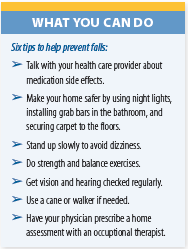Aging Well in Your Own Home
The risk of falls increases with age and can become a serious health problem. According to the National Institute on Aging, more than one in four people over the age of 65 fall each year. More than 3 million people wind up in the emergency room because of a fall, and of those, more than 800,000 sustain injuries that are serious enough to require hospitalization. Sadly, about 32,000 people die from a fall, which can result from head trauma or internal bleeding. Though fractures are more common than deaths from falls, these injuries can take a long time to heal, making people vulnerable to infections. Moreover, it can be difficult to rehab from a fall-related injury. Some people become fearful that they will fall again, so they inhibit their movement and are wary of exercise, which just makes matters worse. Of course, regular exercise is a top fall-prevention strategy. But so is getting a reality check on your home environment and taking action to make it safer.
Where Most Home Falls Occur
Lynette DeFrancia is a licensed and registered occupational therapist (OTR/L) and Inpatient Rehab Supervisor at UCLA Rehabilitation Services in Los Angeles. While falls can occur anywhere in the home, she explains that there are two areas where they are most common: the living room and the bathroom. “In the living room, people can trip over area rugs especially if the edge of the rug is crumpled, raised, not flush with the floor or does not have a non-skid backing. The solution is to remove area rugs altogether or add a non-skid backing to a rug,” DeFrancia explains. “Items that clutter the floor, such as pet’s or children’s toys, are another common problem. Pick up them up as soon as possible, and use a reacher if you have difficulty reaching to get things on the floor.”
Other tripping hazards include low-lying electrical cords, piles of newspapers, and wet bathroom floors. In addition, wobbly tables and chairs can cause people to lose their balance, if they use the furniture to steady themselves or try to stand up.
“In the bathroom, make sure your bath mat has a non-skid backing, immediately wipe up any water that might have gotten on the floor, use non-slip slippers when walking across a large bathroom floor, use a shower chair if you have trouble standing up in the shower or have decreased balance, and install grab bars around the toilet/shower/tub if necessary,” advises DeFrancia.
Lighting, Clutter, Access
As you safety-check your home, a good rule of thumb is to assess each room to ensure there is good lighting, an absence of clutter, and easy access to frequently used items. For example, if your home has stairs, place large rocker light switches at the top and bottom of the stairs. Tighten handrails and consider adding a second handrail if you only have one. Color-contrasting stair treads or edge protectors help add contrast so stairs can be more easily seen. Avoid wearing reading glasses when using stairs. Staircases also should be clutter free.
In the bedroom, a light switch and phone should be within easy reach. The path from the bed to the bathroom should be unobstructed. Place nightlights along the route, motion sensor lights can be a smart way to go.
In the kitchen, place everyday items on lower shelves within easy reach. Have a reacher nearby to grab items on higher shelves. Avoid rugs with corners or edges that can curl up, the best rugs are those with heavy-backed rubber bottoms. Keep paper towels handy so that you can immediately clean up spills.
Outside the home, be on the lookout for cracks in the sidewalk that can cause you to stumble, and fix any wobbly steps. The entrance of the home should be well-lit, and motion sensors are wise here, too. Adding a grab bar near the door also can be helpful to assist you as you step up into the home. If your winters include snow, have a plan for snow removal and deicing the walkways around your home.
A recent study published in the Journal of the American Academy of Orthopaedic Surgeons cited that flooring (33.6%) was the most common product associated with the cause of fractures, with stairs/steps (17.2%) and bed/bed frames (10.9%] being the second and third most common, respectively. Researchers also analyzed a total of 901,418 fall-related visits to the emergency department. Of these, 216,657 (24%) people were found to have fractures. Their average age was 80, with the majority being women (74%).
Be Proactive
Being proactive now can help reduce your fall risk. If you’d like more insights for your specific environment, your physician can order a home safety assessment with an occupational therapist. Occupational therapists (OTs) are licensed health professionals who are skilled at providing recommendations that enhance safety and function in the home. Some OTs have additional training to help people with home modifications and remodels.
specific environment, your physician can order a home safety assessment with an occupational therapist. Occupational therapists (OTs) are licensed health professionals who are skilled at providing recommendations that enhance safety and function in the home. Some OTs have additional training to help people with home modifications and remodels.
The post Aging Well in Your Own Home appeared first on University Health News.

